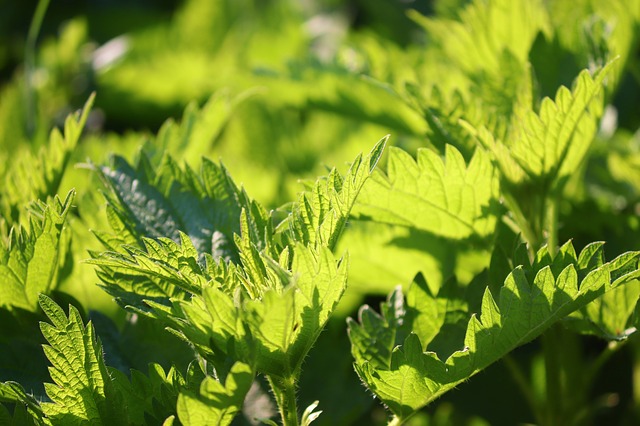 |  |  |  |  |
 |  |  |  |
Common Nettle
is a perennial plant, up to 170 cm tall, with a long creeping, branched root and many small roots. Stems erect, four-sided, grooved. Leaves on petioles, ovate with a pointed tip, with a toothed margin.
Stems and leaves covered with stinging and burning hairs. The hairs are hard and fragile, so when they are pricked, they break off and release formic acid and histamine. Flowers small, unisex, green. Inflorescences placed in leaf axils, long, cob-like, bent. The fruit is an oval nut, yellow-gray in color, 1.2-1.5 cm long. The large nettle blooms from June to September.
Common Nettle
leaves, which are collected during flowering, are used for medicinal purposes. The leaves are cut along with the stems, allowed to twist and when the stinging disappears, the leaves are plucked. Dry in well-ventilated rooms or in dryers not exceeding 40-50C.
The leaves of nettle contain carotenoids (beta-carotene, violaxanthin, xanthophyll, xanthophyll-epoxide); vitamins C, K, B1, B2; tannins (up to 3.2%); chlorophyll (up to 5%); glycoside urticin, flavonoids (up to 1.95%): quercetin, isorhamnetin, kaempferol; organic acids (oxalic acid, formic acid, fumaric acid, lactic acid, succinic acid, citric acid, quinic acid); phenolic carbonate acids (caffeic acid, gallic acid, coumaric acid, ferulic acid); starch (up to 10%); alkaloids (0.010-0.29%): nicotine, histamine, acetylcholine, 5-hydroxytryptamine; coumarin esculetin; macro and micronutrients.
Medicinal significance
Common Nettle
preparations are used in the case of increased menstrual bleeding, during the treatment and recovery of uterine erosion, in the case of climacteric bleeding, fibromyoma, as well as in postpartum and post-abortion cases to straighten the uterus.
Decoction of
Common Nettle
leaves is also used in case of liver and biliary tract problems and worm infestation. In stomatology,
Common Nettle
is also used for the prevention of periodontitis and gingivostomatitis.
In dermatology, this plant is also successfully applied externally in cases of eczema, skin rash, vitiligo (applied to depigmentation areas), furunculosis, purulent wounds, trophic ulcers, to treat seborrhea and skin loss. It can also treat infected wounds and strengthen nasal blood capillaries (in case of frequent nosebleeds), treat burns, traumatic skin damage (bruises, cuts, etc.).
Common Nettle
leaves are included in various biologically active herbal mixtures.
Common Nettle
leaves are used as a blood rejuvenator, increase uterine tone, normalize ovarian menstrual cycle, reduce blood loss in cases of menometrorrhagia, accelerate blood clotting, increase the content of hemoglobin, thrombocytes and erythrocytes in peripheral blood. And
Common Nettle
has other medicinal properties.
In pharmacology, nettle is used as a vasoconstrictor, bile expeller, vitaminizing, urine expeller. Nettle also has properties that promote the regenerating processes of the mucous membranes of the stomach and intestines.
The large nettle activates the metabolism, enhances the activity of many enzymes and enzymes, regulates the activity of the endocrine, nervous, cardiovascular and digestive systems.
The hemostatic properties of this plant are provided by the vitamin K contained in it, which stimulates the production of prothrombin in the liver - it is the most important factor promoting blood clotting.
The sum of the active substances, mainly vitamins and iron salts, which are present in the nettle, normalizes the lipid exchange in the body and has a stimulating effect on the regeneration of erythrocytes.
Nettle leaves increase the activity of the digestive glands and the amount of milk (in nursing mothers), reduce the level of sugar in the blood and urine.
The chlorophyll in nettle leaves has a stimulating and tonic effect, increases the basic metabolism, also promotes the tone of the muscles of the uterus and intestines, strengthens the work of the cardiovascular system and the respiratory system. Stimulates granulation and epithelization of damaged tissues.
Nettle-based ointments have a phytoncide effect on staphylococcus aureus and hemolytic streptococcus, and also treat skin problems that are resistant to antibiotics.
Preparations containing nettle can act prophylactically in case of atherosclerosis, anemia, bronchial asthma, vitamin deficiency. Nettle is a widely used herb in scientific medicine.
The use of nettle in folk medicine has been known for a long time. Even in the Middle Ages, it was widely used in case of lead poisoning, as well as in case of kidney stones.
In ancient times, scientists used this herb widely in the treatment of fever and cancer. Water infusions of nettle flowers, concentrated leaf infusions, and rhizome and root decoctions were used to treat rheumatism, colds, asthma, kidney disease, stomach, malaria, anemia, blood problems, worm infestation, and other problems.
Tautas medicīnā nātri pielieto dzemdes asiņošanas,
balto ziedu, menstruāciju traucējumu gadījumā. Nātre, palīdzēs arī atjaunot
asins sastāvu un dziedēt brūces. Ar nātres novārījumiem taisa kompreses un
skalo augoņus. Ar žāvētu augu palīdzību mazināja asiņošanu no deguna, ar
svaigām lapām dziedēja karpas.
Tautas medicīnā nātres lapu uzlējumu pielieto
nieru un žults ceļu, nierakmeņu, dizentērijas, hronisku aizcietējumu, elpceļu,
hemoroīdu, asa locītavu un muskuļu reimatisma, podagras gadījumos.
Nereti nātres lieto profilaktiski, kā asins
attīrošu līdzekli, kas attīra asins sastāvu dažādu ādas problēmu gadījumā.
Nātres ziedus lieto arī elpceļu ārstēšanā, atkrēpošanas veicināšanai. Sastāvā ar
citām zālītēm to izmanto tuberkulozes ārstēšanā.
Nātrei ir viena unikāla īpašība- tā spēj atjaunot
maņu- smaržu.
Vīriešiem
Lielās nātres saknes sevī ietver tādus savienojumus, kā liposteroīdo kompleksu, kurš bloķē globulīna darbību, saista dzimuma hormonus un bremzē testosterona pārveidošanos, kas nepieciešams normālam prostatas audu stāvoklim. Ir veikti klīniski eksperimenti ar svaigām lielās nātres saknēm, kuras ekstrahētas spirtā. Šis ekstrakts lieliski iedarbojās uz prostatas adenomu.
Nātres sēklas iedarbojas stimulējoši un palielina vīrieša seksuālo interesi. Līdzvērtīgs efekts ir no jaunas nātres, ja to ēd salātos, kopā ar sīpolu un olām.
Lielo nātri izmanto, lai ārstētu prostatas adenomu, neauglību, impotenci, biežas pollūcijas, spermatoreju, akūtu un hronisku prostatītu, kā arī lai pastiprinātu erekciju.
